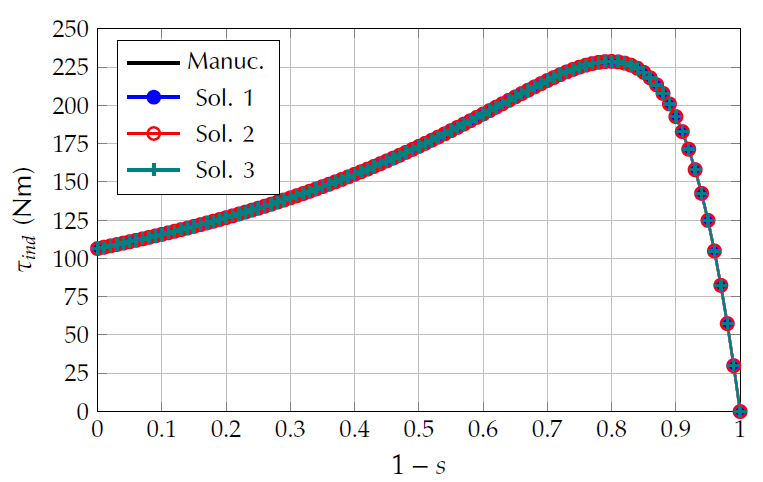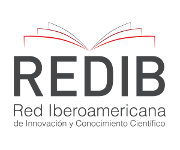
Published
Applying the Sine-Cosine Optimization Algorithm to the Parametric Estimation Problem in Three-Phase Induction Motors
Aplicación del algoritmo de optimización por senos y cosenos al problema de estimación paramétrica en motores de inducción trifásicos
DOI:
https://doi.org/10.15446/ing.investig.110310Keywords:
Mataheuristic optimization, electrical circuit characterization, multimodal optimization problem, manufacturer data (en)Optimización metaheurística, caracterización de circuitos eléctricos, problema de optimización multimodal, datos del fabricante (es)
Downloads
The steady-state analysis of electrical machines requires a detailed characterization of their equivalent electrical circuit, which adequately represents the transformation and interaction between electrical and mechanical energy. This research aims to characterize the equivalent circuit of three-phase induction motors by minimizing the mean square error between the measured and calculated torque variables. These torques are obtained from data provided by the manufacturer, including starting, peak, and full-load torques. A metaheuristic optimization technique is applied to solve the resulting nonlinear programming model based on the interactions between the sine and cosine functions. The numerical results obtained with this algorithm demonstrate its efficiency in terms of response quality, reaching objective function values of less than \(1\times10^{-8}\) with regard to the measured and calculated variables. Simulation results in two test systems allow concluding that the parametric estimation problem in three-phase induction motors is a multimodal optimization problem. This implies a potentially infinite set of solutions that minimize the root mean square error and adequately represent the behavior of the motor's output torque under various probable operating conditions.
El análisis del estado estacionario de las máquinas eléctricas requiere una caracterización detallada de su circuito eléctrico equivalente que represente adecuadamente la transformación y la interacción entre energía eléctrica y mecánica. El objetivo de esta investigación es caracterizar el circuito equivalente de motores de inducción trifásicos mediante la minimización del error cuadrático medio entre variables de torque medidas y calculadas. Estos torques se obtienen de datos suministrados por el fabricante, incluyendo los torques inicial, máximo y de carga plena. Se aplica una técnica de optimización metaheurística para resolver el modelo de programación no lineal resultante, que se basa en las interacciones entre las funciones de seno y coseno. Los resultados numéricos obtenidos con este algoritmo demuestran su eficiencia en términos de calidad de la respuesta, alcanzando valores de función objetivo de menos de \(1\times10^{-8}\) respecto a las variables medidas y calculadas. Los resultados de simulaciones realizadas en dos sistemas de prueba permiten concluir que el problema de estimación paramétrica en motores de inducción trifásicos es un problema de optimización multimodal. Esto implica un conjunto de soluciones potencialmente infinitas que minimizan el error cuadrático medio y representan adecuadamente el torque de salida del motor en varias condiciones probables de operación.
References
Abo-Khalil, A. G., Abdelkareem, M. A., Sayed, E. T., Maghrabie, H. M., Radwan, A., Rezk, H., & Olabi, A. G. (2022). Electric vehicle impact on energy industry, policy, technical barriers, and power systems. International Journal of Thermofluids, 13, 100134. https://doi.org/10.1016/j.ijft.2022.100134
Aminu, M. (2019). A parameter estimation algorithm for induction machines using artificial bee colony (ABC) optimization. Nigerian Journal of Technology, 38(1), 193. https://doi.org/10.4314/njt.v38i1.24
Attia, A.-F., Sehiemy, R. A. E., & Hasanien, H. M. (2018). Optimal power flow solution in power systems using a novel Sine-Cosine algorithm. International Journal of Electrical Power & Energy Systems, 99, 331–343. https://doi.org/10.1016/j.ijepes.2018.01.024
Avalos, O., Cuevas, E., & Gálvez, J. (2016). Induction motor parameter identification using a gravitational search algorithm. Computers, 5(2), 6. https://doi.org/10.3390/computers5020006
Bocanegra, S. Y., Montoya, O. D., & Molina, A. (2021). Sine-cosine optimization approach applied to the parametric estimation in single-phase transformers by considering voltage and current measures. DYNA, 88(219), 19–27. https://doi.org/10.15446/dyna.v88n219.93670
Bouakkaz, A., Mena, A. J. G., Haddad, S., & Ferrari, M. L. (2021). Efficient energy scheduling considering cost reduction and energy saving in hybrid energy system with energy storage. Journal of Energy Storage, 33, 101887. https://doi.org/10.1016/j.est.2020.101887
Ćalasan, M., Micev, M., Ali, Z. M., Zobaa, A. F., & Aleem, S. H. E. A. (2020). Parameter estimation of induction machine single-cage and double-cage models using a hybrid simulated annealing-evaporation rate water cycle algorithm. Mathematics, 8(6), 1024. https://doi.org/10.3390/math8061024
Chauhan, R. K., Chauhan, K., & Badar, A. Q. (2022). Optimization of electrical energy waste in house using smart appliances management system: A case study. Journal of Building Engineering, 46, 103595. https://doi.org/10.1016/j.jobe.2021.103595
Fortes, M. Z., Ferreira, V. H., & Coelho, A. P. F. (2013). The induction motor parameter estimation using genetic algorithm. IEEE Latin America Transactions, 11(5), 1273–1278. https://doi.org/10.1109/tla.2013.6684404
Friederici, P. (2021). In Germany, the energy transition continues. Bulletin of the Atomic Scientists, 77(2), 82–85. https://doi.org/10.1080/00963402.2021.1885851
Gupta, R. A., Wadhwani, A. K., & Kapoor, S. R. (2011). Early estimation of faults in induction motors using symbolic dynamic-based analysis of stator current samples. IEEE Transactions on Energy Conversion, 26(1), 102–114. https://doi.org/10.1109/tec.2010.2062514
Gulbahçe, M. O., & Karaaslan, M. E. (2021). Estimation of induction motor equivalent circuit parameters from manufacturer’s datasheet by particle swarm optimization algorithm for variable frequency drives. Electrica, 22(1), 16–26. https://doi.org/10.5152/electrica.2021.21122
Huynh, D. C., & Dunnigan, M. W. (2010). Parameter estimation of an induction machine using a dynamic particle swarm optimization algorithm. In 2010 IEEE International Symposium on Industrial Electronics. IEEE. https://doi.org/10.1109/isie.2010.5637818
Lindenmeyer, D., Dommel, H., Moshref, A., & Kundur, P. (2001). An induction motor parameter estimation method. International Journal of Electrical Power & Energy Systems, 23(4), 251–262. https://doi.org/10.1016/s0142-0615(00)00060-0
Mohammadi, H. R., & Akhavan, A. (2014). Parameter estimation of three-phase induction motor using hybrid of genetic algorithm and particle swarm optimization. Journal of Engineering, 2014, 1–6. https://doi.org/10.1155/2014/148204
Montoya, O. D., Gil-González, W., & Grisales-Noreña, L. F. (2020). Sine-cosine algorithm for parameters’ estimation in solar cells using datasheet information. Journal of Physics: Conference Series, 1671(1), 012008. https://doi.org/10.1088/1742-6596/1671/1/012008
Nota, G., Nota, F. D., Peluso, D., & Lazo, A. T. (2020). Energy efficiency in industry 4.0: The case of batch production processes. Sustainability, 12(16), 6631. https://doi.org/10.3390/su12166631
Payán, M. B., Fernandez, J. M. R., Ortega, J. M. M., & Santos, J. M. R. (2019). Techno-economic optimal power rating of induction motors. Applied Energy, 240, 1031–1048. https://doi.org/10.1016/j.apenergy.2019.02.016
Pedra, J., & Corcoles, F. (2004). Estimation of induction motor double-cage model parameters from manufacturer data. IEEE Transactions on Energy Conversion, 19(2), 310–317. https://doi.org/10.1109/tec.2003.822314
Rengifo-Santana, J. W., Benzaquen-Suné, J., Aller-Castro, J. M., Bueno-Montilla, A. A., & Restrepo-Zambrano, J. A. (2015). Parameter estimation method for induction machines using instantaneous voltage and current measurements. Revista Facultad de Ingeniería Universidad de Antioquia, 75, 57–66. https://doi.org/10.17533/udea.redin.n75a07
Sengamalai, U., Anbazhagan, G., Thentral, T. M. T., Vishnuram, P., Khurshaid, T., & Kamel, S. (2022). Three phase induction motor drive: A systematic review on dynamic modeling, parameter estimation, and control schemes. Energies, 15(21), 8260. https://doi.org/10.3390/en15218260
Toliyat, H., Levi, E., & Raina, M. (2003). A review of RFO induction motor parameter estimation techniques. IEEE Transactions on Energy Conversion, 18(2), 271–283. https://doi.org/10.1109/tec.2003.811719
Trisha, Gupta, G. S., & Kumar, S. S. (2021). Review of the parameter estimation and transient analysis of three-phase induction motor. In M. J. B. Reddy, D. K. Mohanta, D. Kumar, & D. Ghosh (Eds.), Advances in smart grid automation and Industry 4.0 (pp. 223–232). Springer Singapore. https://doi.org/10.1007/978-981-15-7675-1_21
Véliz-Tejo, A., Travieso-Torres, J. C., Peters, A. A., Mora, A., & Leiva-Silva, F. (2022). Normalized-model reference system for parameter estimation of induction motors. Energies, 15(13), 4542. https://doi.org/10.3390/en15134542
How to Cite
APA
ACM
ACS
ABNT
Chicago
Harvard
IEEE
MLA
Turabian
Vancouver
Download Citation
CrossRef Cited-by
1. Funso Kehinde Ariyo, Oluwamayowa Musa, Opeyemi Owolabi. (2025). Application of Gröbner Basis Algorithm for Estimating Induction Motors Parameters. International Journal of Engineering Research in Africa, 73, p.135. https://doi.org/10.4028/p-LvJ776.
Dimensions
PlumX
Article abstract page views
Downloads
License
Copyright (c) 2024 Santos Daniel Niño-Callejas, Juan Camilo Palombi-Gómez, Oscar Danilo Montoya-Giraldo

This work is licensed under a Creative Commons Attribution 4.0 International License.
The authors or holders of the copyright for each article hereby confer exclusive, limited and free authorization on the Universidad Nacional de Colombia's journal Ingeniería e Investigación concerning the aforementioned article which, once it has been evaluated and approved, will be submitted for publication, in line with the following items:
1. The version which has been corrected according to the evaluators' suggestions will be remitted and it will be made clear whether the aforementioned article is an unedited document regarding which the rights to be authorized are held and total responsibility will be assumed by the authors for the content of the work being submitted to Ingeniería e Investigación, the Universidad Nacional de Colombia and third-parties;
2. The authorization conferred on the journal will come into force from the date on which it is included in the respective volume and issue of Ingeniería e Investigación in the Open Journal Systems and on the journal's main page (https://revistas.unal.edu.co/index.php/ingeinv), as well as in different databases and indices in which the publication is indexed;
3. The authors authorize the Universidad Nacional de Colombia's journal Ingeniería e Investigación to publish the document in whatever required format (printed, digital, electronic or whatsoever known or yet to be discovered form) and authorize Ingeniería e Investigación to include the work in any indices and/or search engines deemed necessary for promoting its diffusion;
4. The authors accept that such authorization is given free of charge and they, therefore, waive any right to receive remuneration from the publication, distribution, public communication and any use whatsoever referred to in the terms of this authorization.


























